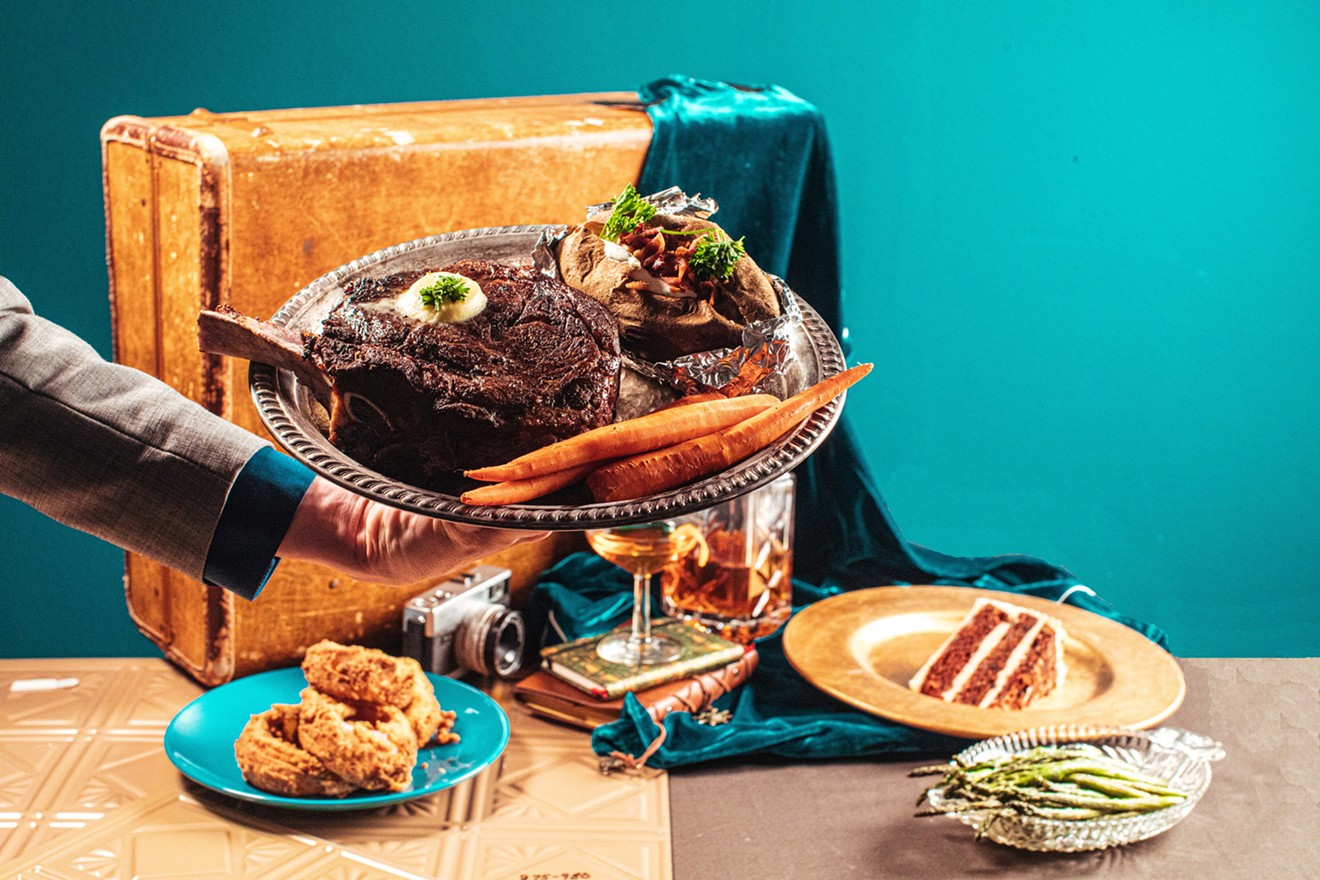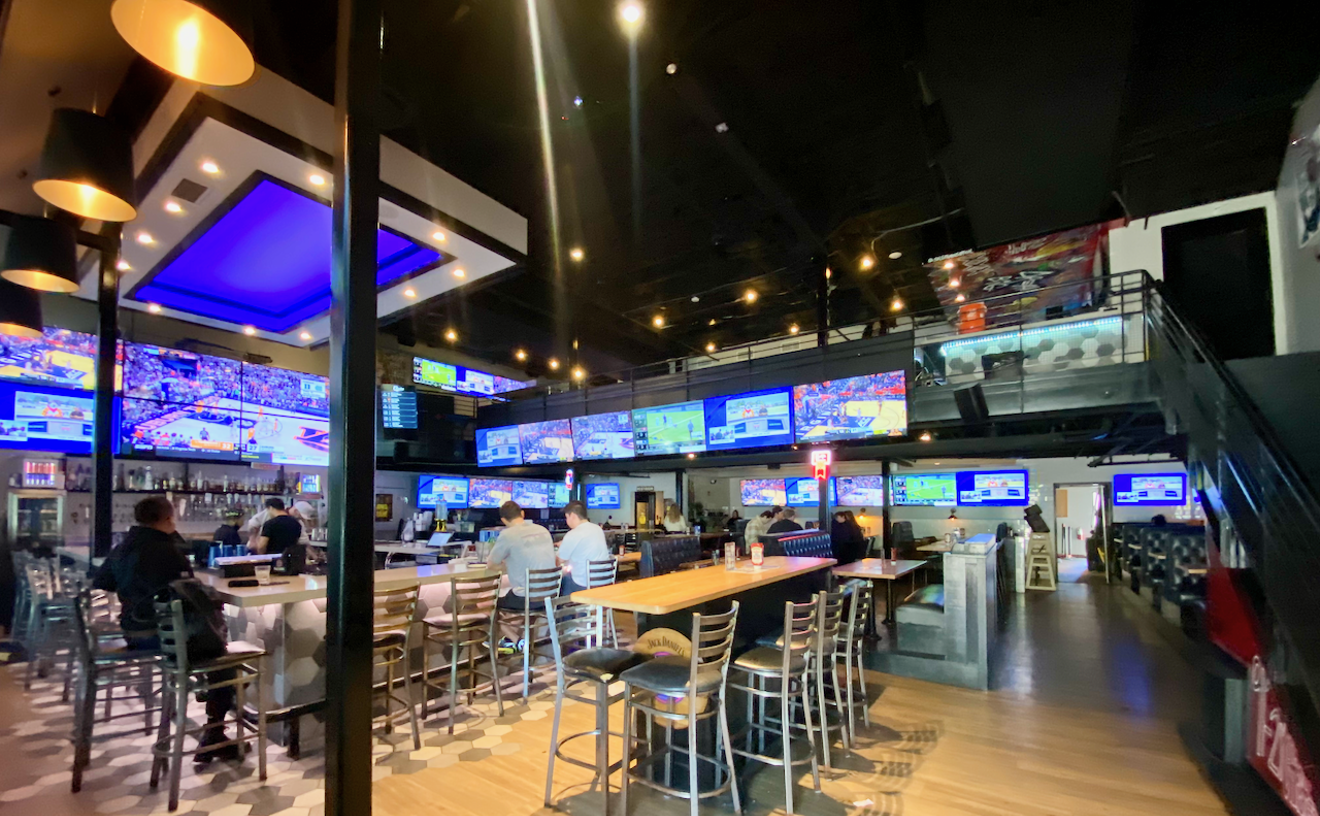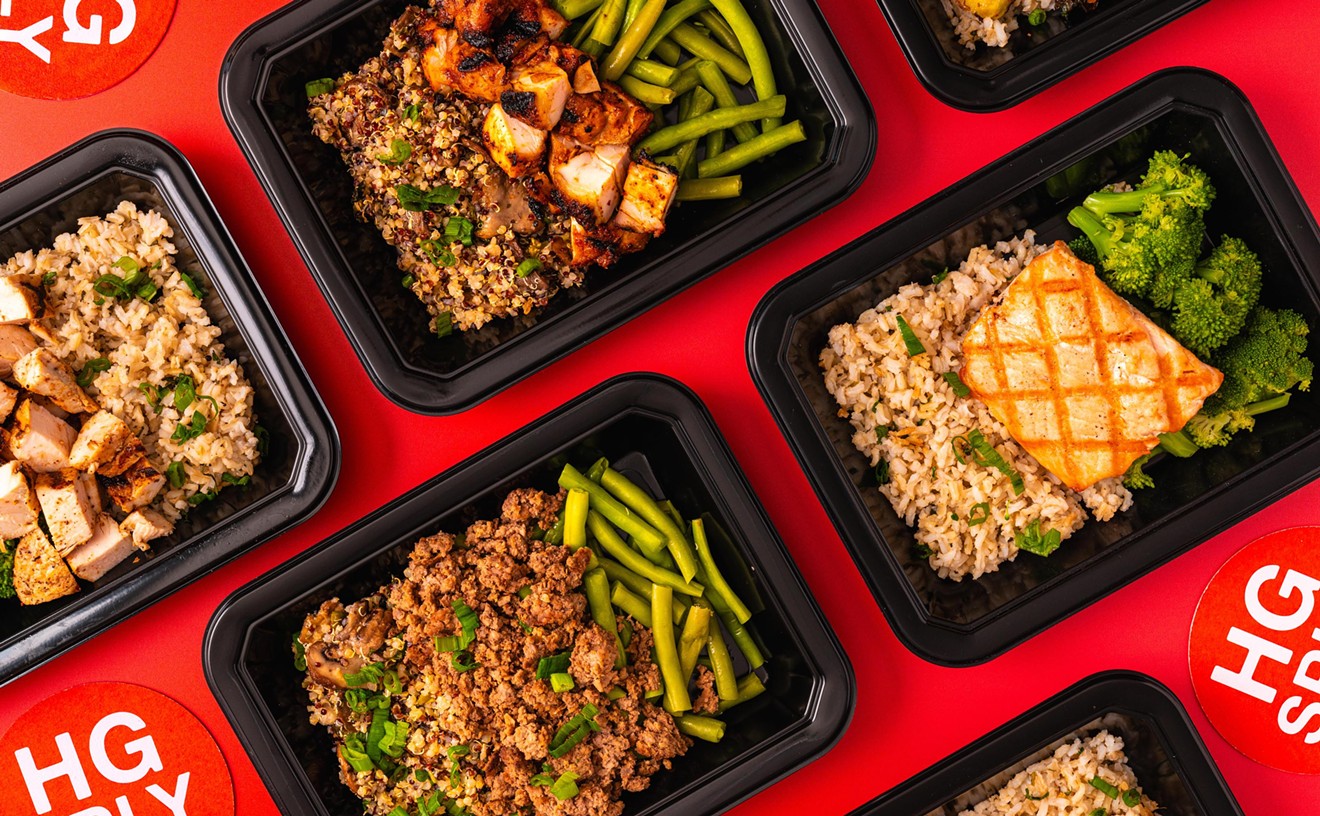In almost every affluent neighborhood in town, steakhouses serve big grilled cuts of beef and big tannic bottles of cabernet sauvignon to diners who are either dressed in their finest or so obscenely wealthy that they could wear pajamas and get away with it. Some steakhouses still operate as boys’ clubs, the walls studded with trophies and sports memorabilia, the men’s rooms decorated with pictures of scantily clad women.
Everyone knows how these restaurants operate. Meats are served a la carte; mashed potatoes and other sides cost an extra $7-10 each. Seafood cocktails are essential starters. Quality macaroni and cheese separates the good from the great. The menu will mention dry-aging, even if the meats aren’t dry-aged properly. Waiters can be either polite or condescending, but their goal is to help customers spend as much money as possible.
In the past few decades, the Dallas steakhouse went from a special-occasion restaurant, the kind of place where a customer might slip an engagement ring into a Champagne glass, to an all-the-time restaurant, a haunt for Wednesday night indulgences.
But the tide may be turning. Younger generations of diners can’t afford that kind of excess, eaters concerned about their health or the environment are cutting back on red meat and women bristle at the sexist culture of the most prestigious dining rooms.
It’s time for the meat palace to evolve.
The Dallas steakhouse template is more or less standardized. Most of them offer similar menus, in similar environments, to the same three or four neighborhoods.
“We’re getting dangerously, ridiculously overwrought with them downtown,” John Tesar says. His own steakhouse, Knife, sits a few miles north, in the Highland Dallas hotel. (There’s another location in Plano.) Knife is probably the best and most interesting steak joint in town, but Tesar was genuinely intimidated to open it in such a meat-saturated marketplace.
“People make the mistake of seeing other people’s success and thinking that it’s going to automatically play itself out,” he explains. “That was one of my concerns when I opened Knife. I was afraid of it because I was in Dallas.”
Fear of competition hasn’t stopped other restaurateurs. Nusret Gökçe, the notorious Turkish chef who calls himself “Salt Bae,” plans to open one of his widely mocked steakhouses at 1900 Pearl St. At the time of writing, Nusr-Et is finishing kitchen repairs and seeking a liquor license.“That was one of my concerns when I opened Knife. I was afraid of it because I was in Dallas.” – John Tesar
tweet this
CBD Provisions, a downtown hotel restaurant, recently converted to a steakhouse model. CBD’s parent group, Headington Cos., is also planning to open a steakhouse in the Design District space that formerly housed FT33. (Update: This article originally reported the name as VT Steak House, based on records filed with city government. However, a representative of the restaurant tells the Observer that that name is not official.)
Curtis Stone, an Australia-born, Los Angeles-based judge of TV cooking shows, has plans to open a “redefined steakhouse” in the Knox neighborhood. Stone’s local business partner, Stephan Courseau, asked a Dallas Morning News reporter a question.
“How can we make it interesting so it’s not just one more steakhouse?” he said. “Dallas doesn’t need another steakhouse.” Courseau offered no answer to his own query.
Gökçe, Headington, Courseau and Stone are facing down established high-end competition from Knife, Town Hearth, Pappas Bros., Bob’s Steak and Chop House, Ferrari’s Italian Villa and Chop House, Dallas Chop House, CBD Provisions, SER Steak and Spirits, Y.O. Ranch, The Hall, Ocean Prime, Corrientes 348, Gorji, Cooper’s, Eddie V’s, Al Biernat’s, Nick and Sam’s, Dakota’s, Chamberlain’s, Jaxx, Nate’s and Arthur’s; bar-and-grill restaurants with strong beef offerings, including Kenny’s Wood Fired Grill, Sevy’s Grill and Neighborhood Services; national chains like The Capital Grille, The Grill on the Alley, Del Frisco’s Double Eagle, Perry’s, Morton’s, Truluck’s and Ruth’s Chris; Brazilian-run Fogo de Chão, Boi na Braza, Carvao, 12 Cuts, Villas, Vila Brazil and Texas de Brazil; older-school joints that represent even earlier traditions, like Dunston’s and Charco Broiler; and restaurants that primarily focus on other types of food but still serve some of the best steaks in town, including Homewood, The Mitchell, Boulevardier, The Heritage Table and an off-menu, call-ahead rib-eye at Sapp Sapp Lao and Thai Kitchen.
In other words, it’s a crowded market.
“In Dallas, steakhouses will always be king,” says Eric Freidline, chef at Sevy’s Grill and a veteran of Chamberlain’s. “People just love a great steak in Dallas.”
Hanging over all of those businesses, though, is Courseau’s question: “How can we make it interesting?” There are, obviously, a handful of stock answers, like adding seafood or being from Brazil.
About 20 years ago, several Dallas steakhouses offered a new solution by introducing sushi bars. Led by Kent Rathbun’s Abacus, the steak-and-sushi concept invited diners to devour as many species of animal as possible in one evening. It made no sense at all.
Sushi and steak have little in common but prestige; together, they make for a protein-heavy meal that gets filling well before the last plate is empty. Critically, the preparations call for different skills and require the hiring of two different staffs. For that reason, there is no guarantee that a grill that nails a flawless medium-rare can also source mouthwatering toro.
As Tesar says of the trend now, “I can make sushi. But I’d rather eat it from somebody who really understands the culture and the cuisine.”
The Hall and Town Hearth, which opened in 2016 and 2017, opted to pair their cuts of meat with a more surprising side dish: raw masculinity. An Observer first look article about The Hall bore the memorable headline, “The Hall at Trinity Groves Feels Kind of Like Eating Steak in a Suburban Dad’s Rec Room.” Author Amanda Albee noted that the room was lined with photographs of old football players.
The Hall is located in the Trinity Groves development; Trinity Groves partner and lead restaurateur Phil Romano recently settled a lawsuit filed by an employee over sexual assault allegations.
The machismo at Town Hearth is even less subtle. Chef-owner Nick Badovinus, who does his own interior decorating, festooned every available surface with sports trophies. Tapes of old football games play on speakers in the bathrooms. The ’74 Ducati Sport in the open kitchen is listed on the menu as a $75,000 side dish.
“People got a lot more ostentatious with it over the years. Before, once in a blue moon, you got a steak. It was a special occasion, for birthdays." – Eric Freidline
tweet this
Men have always marked steakhouses as their territory, of course. But the sheer preposterousness of Town Hearth creates an entirely new sensation: masculinity as kitsch rather than threat.
The boys in the boys’ club will object to the use of the word “threat,” but experiences of women in Dallas steakhouses have traditionally been rife with prejudice and predation. Consider Merritt Tierce’s novel Love Me Back, based in large part on her years as a waitress at Nick and Sam’s. In the book and in interviews, Tierce recounts all sorts of horror stories: handsy clients, private rooms becoming venues for sexist and racist jokes, drug abuse, exploitation by male co-workers.
In a 2014 D Magazine interview about her Nick and Sam’s experiences, Tierce recalled “having to act like I don’t notice the blatant misogyny and the, like, sexual harassment and all of it that’s just rampant and letting people touch me while they’re talking to me.”
Consider, too, the experiences of Eve Hill-Agnus, D Magazine’s food critic, who wrote last year about the misogynistic culture she discovered as a customer at many of Dallas’ top steakhouses. Part of the assault came from fellow patrons loudly commenting on her appearance, but much of the blame lay directly with staff.
At Del Frisco’s, she checked her coat and the clerk handed the claim tab to another guest, “as far as I could tell,” she wrote, “because he was a man.” At Al Biernat’s, a waiter returned Hill-Agnus’ credit card at the end of the meal, then pointedly turned away from her and shook hands with the one man at the table.
“So glad you came in,” the server told that man, ignoring the women in the party.
“Even at Pappas Bros., my pick for the No. 1 steak restaurant in Dallas, our server initially answered all my questions while looking directly at my friend’s husband,” Hill-Agnus writes.
Ultimately, as that top ranking suggests, Hill-Agnus decided not to hold blatantly sexist service against the restaurants in question. But her month of red-meat-eating still left her queasy, and not for digestive reasons. She called it “kid-gloved mistreatment.”
The future of steakhouses does not look like this. The only reason that the present looks like this is our society’s presumption that red meat is for boys and salad is for girls. Like stereotypes about red and white wine, or devouring versus dieting, that caricature is a symptom of deeper sexist codes around the way that Americans eat. It reflects the ugly belief that men should aspire to be successful and women should aspire to be attractive.
When some of those sexist ideas finally die off — along with the older, wealthier diners who perpetuate them — what will become of the machismo-based steakhouse? At best, a place like Town Hearth might survive as a sort of tourist attraction, its cartoonishly silly male fantasy decor resembling the murals of Italian villages painted onto the walls of old spaghetti joints.
On the other hand, a restaurant like Nick and Sam’s bases its entire business model on the continued existence of a class of heterosexual male power brokers.
A steakhouse where everybody feels comfortable may sound obvious, but it’s still a new idea.
Progress has been slow, but steady. The former ladies’ menus, with prices unlisted, are disappearing. Service at many of Dallas’ top steak rooms is gender-neutral; Hill-Agnus singled Knife out for praise, and Tesar proudly showed that praise to his staff at a meeting.
“We want to create a restaurant where everybody feels comfortable,” Tesar says. “We’re not trading baseball players at the back table. We’re not picking up girls at the bar, we’re not doing drugs in the bathroom. I’m sorry. We’re boring. I did that in the ’80s.”
There’s another source of discomfort Tesar in particular has in his sights: class. Not everybody can afford a $120 dry-aged rib-eye at Knife, even if it gets shared by a table of four. That’s why he built an entire menu of hamburgers, given almost as much attention as the aged meats (and getting almost as much love from the press). It’s why Knife serves so many salads and pastas. And it’s why the service is friendlier than usual, too.
“That’s the thing I hate about steakhouses,” Tesar says. “The service always makes me feel like a moron. They always act like it’s your first time ever being in a restaurant.”
One of the city’s newest beef joints cuts the pretense even further, to the point where it may not even qualify as a steakhouse. Cooper’s Meat Market in West Dallas is primarily a butcher shop, but hungry diners can also take a seat at one of the handful of tables and order a grilled cut off the no-frills menu. There’s no need to dress up at Cooper’s; they don’t even have tablecloths.
Slowly, barriers to customers — dress codes, stuffiness, snobbishness, sexism — must come down. The steakhouse needs to be less of a clubhouse for elites and more of an escapist experience for everyone.
That assumes, of course, that the steakhouse can find a way to stay relevant.
Next Gen Steak
If sushi bars and raw machismo have failed to keep diners’ attention, what should steak joints try next? Good-quality meats are increasingly available at stores like Central Market or Cooper’s, which means that home cooks see less appeal in going out. More important, diners are growing concerned about the ethical implications of a meaty binge. Are the cows raised humanely? Do meals like this exacerbate our global climate catastrophe?Concerns like these have led many of Dallas’ best restaurants to Texas ranches with environmentally conscious practices. 44 Farms is a source for Mudhen Meat and Greens, burger chain Rodeo Goat, Y.O. Ranch Steakhouse and most of all Knife, where Tesar believes that cows taste better when they’ve lived well and eaten healthy diets. 44 Farms cattle are fed a mixture of corn, sorghum and molasses; they’re branded using dry ice rather than hot metal, and the farm is tended on horseback rather than tractor.
“Every decision, every action on the farm, trickles down to the cattle’s experience,” wrote Observer writer Nick Rallo in a 2016 visit to the fields.
There’s a big environmental difference between a conscientiously operated ranch and a commodity slaughterhouse that funnels hundreds of animals into one lot. Jon Taggart, who runs Burgundy Pasture Beef, described himself in a 2017 interview as a “conservative environmentalist” who avoids feed lots, antibiotics and herbicides, and has a solar-powered well pump.
“The fertilizers, the herbicides — I just didn’t see the benefits coming from the cost, then when you throw the environmental issues on top of that, to me, it just didn’t make sense in my own little world,” Taggart told the Observer. “We took 1,400 acres — 900 of it was plowed farmland — and converted that all back to grass over, like, 10 years. It’s kind of a tedious process.”
But it’s an increasingly necessary process. For one thing, customers care more than ever about the pedigree of their product; for another thing, they can taste the difference. But long term, the global environment is the biggest threat to a steakhouse’s product and its supply chain.
The environmental threat comes in two primary forms: climate change and consumer demand. In 2012, a catastrophic drought crippled Texas and forced many ranchers to sell off their herds. Such dramatic shifts in climate fortune will only become more common in the next few decades.
And, increasingly, customers are aware that they should probably be eating less red meat. A United Nations report this summer firmly advocated for a diet less focused on meat. Reactions were mostly negative, because the meat industry wants to keep sales strong and diners want to keep indulging in pork chops. Dallasites won’t easily be persuaded to cut back.
All the same, generational gaps are becoming apparent. Younger diners can’t afford to splurge on a big cut of steak. They frequently want to share a series of small plates, rather than hoard main courses to themselves.
There’s more: USDA survey data indicate that beef consumption per capita peaked in 1976 and has declined ever since, including a 14% drop between 2006 and 2016.
Research firm GlobalData reported that between 2014 and 2017, the percentage of Americans self-reporting as vegan increased from 1% to 6%. In 2017, GrubHub reported a 19% increase in vegan orders; the following year, GrubHub said that the biggest ordering fad, edging out even poke, was meatless burritos.
Where will that leave the steakhouse?
Tesar has dabbled with meat substitutes, like the Impossible Burger, but the substitute field focuses mainly on ground “meat,” not whole cuts of imitation animal.
In 2018, Dallas’ French Room attempted the impossible by grilling a slab of eggplant like a New York strip, even marinating it in beet juice to mimic blood. The result was uncannily steak-like, with a pink middle, but not necessarily delicious.
Tesar says he sees substitutes working “only at the fast-casual level at this point.”
“I’ve used those products,” he explains. “A chef can create a Salisbury steak with it. You can fool people. I can make it taste just like a Big Mac, and they wouldn’t know the difference, with what you put on it.”
But high-end diners are fixed in their love of the real thing, at least in Dallas and at least for now.
“I don’t see people slowing down on red meat,” Freidline says. “You’re definitely still living in a meat-eater society.”
Freidline admits that, at Sevy’s, he has noticed a change in meat-eating habits.
“At lunchtime we start seeing a lot more butter on the side, no breading,” he says. “I stay away from heavy cream sauces at lunch. If I make a chicken-fried steak sandwich, it won’t sell. I think people are more lenient at dinner. They want the butter and the fat. They’ve worked all day and they deserve it.”
Maybe Dallas will continue to be a meat capital. Or maybe lunch hour at Sevy’s is a look into the future. Even if we wish it to be otherwise, however, the idea of rib-eyes as all-the-time dietary staples is simply unsustainable.
“People got a lot more ostentatious with it over the years,” Freidline says. “Before, once in a blue moon, you got a steak. It was a special occasion, for birthdays. I saw it become more of a norm of hey, let’s go out and grab dinner at a steakhouse and have some nice wines. Meat in general became less of a once-a-week deal and more of an all-the-time sort of thing.”
Though the biggest spenders are aging — and younger generations aren’t learning the same indulgent habits — expense accounts continue to give upper-crust professionals access to even more money than they already have. As a result, steakhouses don’t feel much incentive to attract new customers.
“When you look at it from the restaurant’s point of view, the older generation has a lot more money and is willing to spend a lot more money,” Freidline explains. “If your crowd is between 40 and 60, that’s prime time to spend a little more on a bottle of wine. If your table is younger, the check average will be considerably lower.”
It’s not so much that young people aren’t interested in old-fashioned steakhouses; it’s that old-fashioned steakhouses aren’t interested in young people.
Still, it’s easy to see what a new generation of steakhouse could look like. It will honor top-quality meat, sourced from ethical purveyors who seek to reduce their environmental impacts. It will probably involve the meat being the centerpiece of a more balanced family-style shared meal with lots of starters and vegetables. There may be alternative cuts of meat, too, including offal.
A meal may become more affordable as the ratio of meats to sides changes. New steakhouses might, like Cooper’s, eschew the tablecloths and formal service. They will certainly cut out the misogynist, classist old ways that have long tied these businesses to clubby men. They may even, like Rachel Yang’s spectacular Joule in Seattle, bring immigrant cultures into the traditional template.
The challenge will be incorporating that vision into a framework that still keeps the essential Dallas spirit alive.
“I hope Dallas doesn’t lose its sense of being Dallas because of the influx of all these people,” Tesar says. “That’s part of the charm of it. Don’t take that history away.”
Then he recounts a story of a recent dinner.
“I had dinner at Pappas Bros. the other night,” he says. “I ordered a 45-day dry-aged rib-eye, a 2-pound lobster, a mac and cheese just because I wanted to see it, and some mushrooms and shrimp cocktail and a Caesar salad. I went there for that very reason. I wanted to go to a traditional steakhouse. I just wanted that environment. I knew what to expect. The steak was very good — properly cooked. I didn’t taste the dry aging, or it wasn’t an exceptional steak. The lobster was fresh and taken out of the shell for us.
“The service was impeccable. They knew who I was, but they do that for everyone in general. There’s something to staying power, there’s something to integrity. It’s tradition. It’s part of the American dining framework.”
Asked if a great Dallas steakhouse will look dramatically different in 20 years, Tesar answers, “I hope so. But I still hope Pappas Bros. is there. I don’t think that should go away.”
















